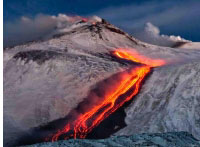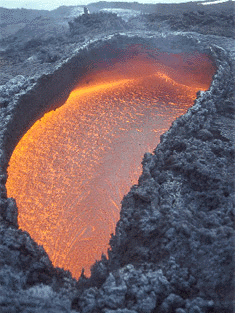...Best of Sicily presents... Best of Sicily Magazine. ... Dedicated to Sicilian art, culture, history, people, places and all things Sicilian. |
by Vincenzo Mormino | ||
Magazine Index Best of Sicily Arts & Culture Fashion Food & Wine History & Society About Us Travel Faqs Contact Map of Sicily
|
And yet certain volcanoes lightly stand out more than others, especially where nearby inhabitants have long considered them the sites of mystical or even sacred happenings. In this respect there are a few which seem particularly distinguished: Fuji in Japan, Kilimanjaro straddling the border of Tanzania and Kenya, Haleakala in Hawai'i, and, of course, Sicily's Etna. With the worthy exception of Mount Olympus, Mount Etna is the closest thing that ancient Europe ever had to a sacred mountain. Vesuvius threatened, and eventually destroyed, Pompeii, and still thunders at the Neapolitans, but Etna, whose mystical legacy dates at least from the days of the ancient Greeks (and possibly to the religion of neolithic Sicilians), enjoys a special place in classical literature and mythology. Indeed, certain myths relating to Etna are, in effect, metaphors for specific natural occurrences. Homer's Odyssey is the source of some of these legends, but more of them probably evolved much earlier, perhaps before the arrival of the Greeks, when a people called the Sikels (Siculi) inhabited eastern Sicily. Two gods bear mentioning. Vulcan (or Vulcanus, the Greeks' Haephestus) was the god of the forge and (in some interpretations) the god of fire. That such a deity would dwell in a place that spurted flame is not surprising, and it's easy to imagine Etna as a giant forge since, in a sense, it is one, releasing molten rock which cools into a hard substance. Few who have not read classical mythology have ever heard of Vulcan, though he (and his torrid realm) were the inspiration for a planet and race in the Star Trek television series. Next we meet the giant one-eyed Cyclops. Here too we have an allusion to the "eye" of the volcano, though Etna's volcanic typology, in contrast to that of Vesuvius, has more than one vent (a fact which might be lost on ancient observers who visited the summit only infrequently and therefore saw only one big hole spewing molten lava). The giant Cyclops, of course, is best known for menacing Odysseus and his men. Enkelados (Enceladus) was one of the Gigantes (not to be confused with the Titans), the giant progeny of Gaia (identified as the Earth). Wounded during a battle with the gods, he was buried in Sicily, where Etna's fire and fumes are said to be his breath, and earthquakes his painful movements. The minor god Silenus also figures in the legends of Mount Etna. He was one of the ipotanes. These creatures, usually connoted as two-legged, were half horse and half human. (There are subtle distinctions among these semi-human creatures; satyrs were part goat, minotaurs part bull, and centaurs usually had four legs instead of the ipotanes' two.) A few other local forces are worth mentioning. Aeoleos was the god of the winds, for whom the Aeolian (Lipari) Islands are named. Scylla and Charybdis guarded the Strait of Messina, where whirlpools of the past may have been a serious threat to small ships. Etna is dangerous enough even without Vulcan and the Cyclops. A few centuries ago an eruption sparked a massive a lava flow which destroyed much of Catania, and the communities on some higher slopes have suffered damage in recent decades. Mount Blank, the Matterhorn and several peaks in the Urals merit our attention, even respect, but Etna is Europe's greatest natural wonder. It was Christianity that finally put to rest the popular legends attributed to Europe's highest volcano. Belief in one God identified strongly with a place beyond our world made mythological mysticism obsolete. Mount Etna has earned a special place among volcanoes. Its recorded history is older than that of other volcanoes, thus providing us with useful information on the behaviour of volcanoes over time. And it still makes the occasional literary or cinematic appearance literally firing our imagination. A few years ago, George Lucas hopped over to Sicily with a film crew to film an erupting Etna for a dramatic scene in the Star Wars series which takes place on a volcanic planet. Europe's sacred mountain, it seems, had lost none of her ancient, otherworldly muster. About the Author: Vincenzo Mormino has written about wildlife and nature for Best of Sicily and hard-copy publications. | |
Top of Page |

 There's something about mountains
that fills us with awe. It's not just a poetic sense of grandeur, but something
primeval, dating from the remote times when the first humans walked the
Earth. Maybe it's in our genes. Perhaps it's rooted in our curiosity of
views from high places, or just wanting to reach a place where, we might
prefer to believe, nobody (at least no other human) has ever set foot before.
Whatever it is, it's the high volcanoes that evoke special emotions. They're
a rarity. True, certain regions have more of them than others - Hawai'i
and southern Italy come to mind - but the fact remains that entire countries
and geographic regions lack volcanoes. They're certainly not a feature one
readily associates with the deserts of Saudi Arabia, the rolling green hills
of Ireland or the Adirondacks of the United States.
There's something about mountains
that fills us with awe. It's not just a poetic sense of grandeur, but something
primeval, dating from the remote times when the first humans walked the
Earth. Maybe it's in our genes. Perhaps it's rooted in our curiosity of
views from high places, or just wanting to reach a place where, we might
prefer to believe, nobody (at least no other human) has ever set foot before.
Whatever it is, it's the high volcanoes that evoke special emotions. They're
a rarity. True, certain regions have more of them than others - Hawai'i
and southern Italy come to mind - but the fact remains that entire countries
and geographic regions lack volcanoes. They're certainly not a feature one
readily associates with the deserts of Saudi Arabia, the rolling green hills
of Ireland or the Adirondacks of the United States.